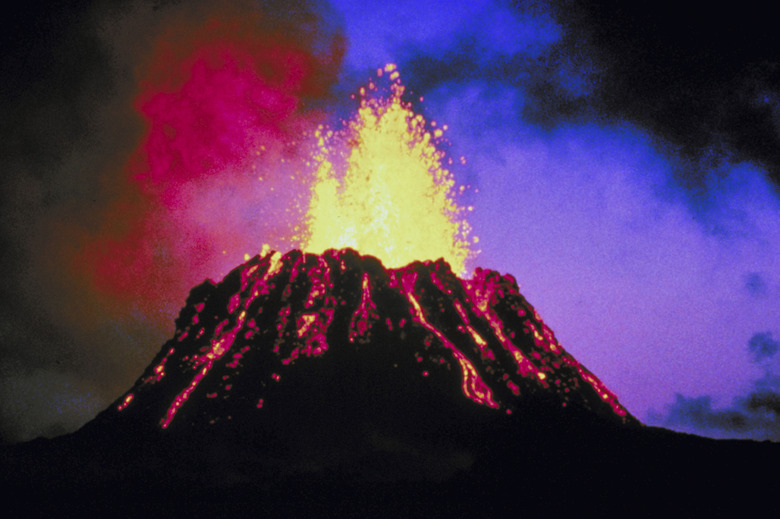Examples Of Dust From Volcanic Eruptions Blocking The Sun
When volcanoes erupt, they spew plumes of ash and gases into the atmosphere. The ash has the immediate effect of darkening the sky around the volcano, turning it black and hazy and coating the ground with thick layers of dust. Sulfur dioxide gas, mixed with ash particles, enters the troposphere and stratosphere and can spread around the Earth within weeks. The sulfur dioxide mixes with water; together with ash, these volcanic emissions block solar energy from fully reaching the Earth's surface.
1815: Tambora
1815: Tambora
On April 5 and 10, 1815, the South Pacific volcano Tambora erupted twice, sending 12 cubic miles of magma and 36 cubic miles of rock into the atmosphere. Its ash cloud blackened the region, killing 92,000 people and destroying crops. The following year, 1816, became known as the "year without a summer." The volcanic ash and gases in the atmosphere caused weak sunlight that year. Temperatures dropped globally, causing crop-killing droughts and extreme storms like heavy monsoons and summer snows across the Northern Hemisphere.
1883: Krakatoa
1883: Krakatoa
A volcano on the South Pacific island of Krakatoa erupted on August 27, 1883. Its explosions could be heard 2,800 miles away in Perth, Australia, releasing about 11 cubic miles of ash and rock into the air. The skies within 275 miles were darkened by the ash cloud, and the area would not see light for three days. The explosion also released sulfur dioxide into the upper atmosphere, cooling the Earth for five years.
1980: Mount St. Helens
1980: Mount St. Helens
Between March 16, 1980, and May 18, 1980, U.S. Geological Survey scientists watched Mount St. Helens in Washington closely. The mountain was rocked by some 10,000 earthquakes over that time, and its north face grew a 140-meter bulge due to rising magma. When the volcano erupted on May 18, a rising column of ash and sulfuric gas was released into the atmosphere. Areas like Spokane, Washington, (250 miles from the blast site) were engulfed in near-complete darkness by the eruption's ash cloud, and visible ash blocked the sun as far away as 930 miles east in the Great Plains. It took three days for the ash cloud to spread across the nation, and 15 for it to encircle the globe.
1991: Mount Pinatubo
1991: Mount Pinatubo
In the midst of a typhoon, Mount Pinatubo exploded on June 15, 1991, in the Philippines. Its ash cloud reached 22 miles high, and was spread haphazardly throughout the region by the intense typhoon winds; some ash even settled in the Indian Ocean. The eruption sent 20 million tons of sulfur dioxide into the stratosphere, causing two years of global cooling by 1 degree Fahrenheit.
References
- Scientific American: How Do Volcanoes Affect World Climate?
- Wired: April 10, 1815: Tambora Explosion Triggers 'Volcanic Winter'
- LiveScience: Krakatoa Volcano: Facts About 1883 Eruption
- U.S. Geological Survey: Mt. St. Helens 1980 Cataclysmic Eruption
- U.S. Geological Survey: The Cataclysmic 1991 Eruption of Mount Pinatubo, Philippines
Cite This Article
MLA
Laine, David C.. "Examples Of Dust From Volcanic Eruptions Blocking The Sun" sciencing.com, https://www.sciencing.com/examples-dust-volcanic-eruptions-blocking-sun-14361/. 24 April 2017.
APA
Laine, David C.. (2017, April 24). Examples Of Dust From Volcanic Eruptions Blocking The Sun. sciencing.com. Retrieved from https://www.sciencing.com/examples-dust-volcanic-eruptions-blocking-sun-14361/
Chicago
Laine, David C.. Examples Of Dust From Volcanic Eruptions Blocking The Sun last modified March 24, 2022. https://www.sciencing.com/examples-dust-volcanic-eruptions-blocking-sun-14361/
